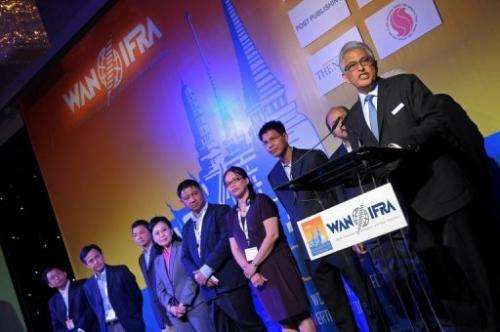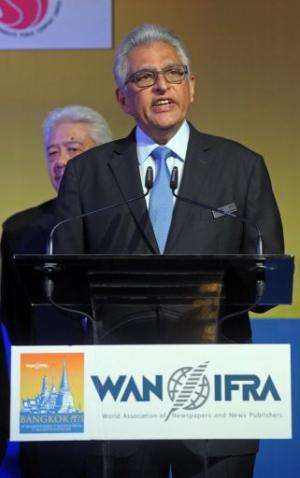President of the World Association of Newspapers and News Publishers (WAN-IFRA), Jacob Mathew, (R), alongside delegates from local newspapers, addresses the 65th World Newspaper Congress in Bangkok, on June 2, 2013. More than 1,000 publishers, editors and other figures from the media gather for the World Newspaper Congress taking place from June 2-5.
Global newspaper chiefs have some rare good news to share after years of slumping print sales and advertising revenues—readers appear increasingly willing to pay for online news.
More than 1,500 newspaper editors and other media figures are meeting in Bangkok this week as papers continue to shed readers—at least in the older markets—and the shift to the Internet draws more "eyeballs" but lower ad rates.
Press freedom, journalist safety, the use of new technology and future trends in print and advertising will also be discussed at the four-day annual World Newspaper Congress, which runs until June 5.
The issue of charging readers for web and mobile content looms largest, with editors casting an envious eye at media groups which have successfully implemented "paywalls" after years of giving away news for free.
"The general impression was that it would be impossible to reverse the culture of free (online) content... that people will never pay for it," said Gilles Demptos of the World Association of Newspapers and News Publishers.
"The great news is, that is changing dramatically," he added, citing the boom in paid-for online subscriptions for the "high-quality" journalism of the New York Times and Financial Times.
Last month the New York Times became the second most-read US daily newspaper, with a circulation of over 1 million. The figure was boosted by 325,000 new digital readers who have joined since a paywall was introduced in 2011.
For $35 a month subscribers gain unlimited access to the New York Times' website and mobile apps, while casual visitors to its website can still read 10 articles without charge per month.
The paywall trend—either full or "metered"—has tentatively taken off across the world, although many publishers closely guard the numbers of paying subscribers signed up.
Chairman of Asia Pacific Committee of the World Association of Newspapers and News Publishers (WAN-IFRA), Pichai Chuensuksawadi, speaks during the 65th World Newspaper Congress in Bangkok, on June 2, 2013. More than 1,000 publishers, editors and other figures from the media gather for the World Newspaper Congress, taking place from June 2-5.
Newspapers have few choices as advertisers continue to baulk at spending on a diffuse online audience the sums which editors want—and need—to sustain quality journalism.
WAN-IFRA said newspaper circulation had slumped by 13 per cent in North America over the last five years; nearly 25 percent in western Europe; and 27 percent in eastern Europe.
But with Asian print circulation surging nearly 10 percent in that period, more than half the world's adult population now read a daily newspaper, equating to 2.5 billion in print and more than 600 million in digital form, the study found.
In the US, where print advertising revenue has collapsed by 42 percent since 2008, publishing companies have been bold in embracing paywalls with the nation's largest—Gannett—charging for access to all of its 80 websites.
"Hundreds of newspapers have taken the premium or fremium or metered route for making money from their online content," WAN-IFRA president Jacob Mathew told delegates.
"No one knows which of these is the best route, but it's heartening to note the impact that content paywalls are having on circulation revenues."
President of the World Association of Newspapers and News Publishers (WAN-IFRA), Jacob Mathew, speaks during the 65th World Newspaper Congress in Bangkok, on June 2, 2013. More than 1,000 publishers, editors and other figures from the media gather for the World Newspaper Congress, taking place from June 2-5.
While that should be a harbinger of better times ahead, analysts say it is a model that may only buoy top-end titles such as the New York Times, even though just a fraction of its unique users now pay for content.
"There are many newspapers that are not very good that are trying to charge and I do not believe that will work," said media commentator and blogger Jeff Jarvis, of the City University of New York.
Moreover, the newspaper industry's "infatuation with paywalls" was encouraging it "to replicate its old, industrial business models in a new, digital reality", he said, adding the real problem remains a lack of "engagement" with web communities.
Those young, tech-savvy communities are increasingly receiving their information on reader-driven social news sites such as BuzzFeed.com or Reddit, which says 70 million people visited its site last month.
Newspapers should prioritise "building a stronger relationship with the public we serve", Jarvis said, warning success in doing so will dictate the odds of long-term survival.
But it is not all doom and gloom for news chiefs, with many Asian print markets booming in parallel with their economies and increasingly literate and aspirational populations.
"It's still a growth market driven mainly by China, India and Indonesia," said Pichai Chuensuksawadi editor-in-chief of Thailand's Post Publishing, which counts the daily Bangkok Post in its stable.
In neighbouring Myanmar, relaxed censorship following the end of military rule has transformed the media sector, with privately owned daily newspapers hitting the streets in April for the first time in decades.
© 2013 AFP

























